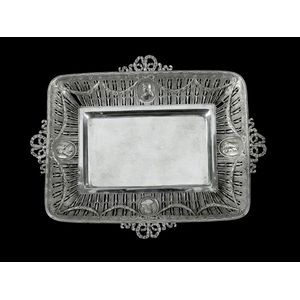Hanau Silver Tray with Portrait Medallions and Swags
20th century German silver tray. With Hanau pseudo hallmarks. Rectangular tray in 18th century taste with reticulated gallery featuring four portrait medallions and swags. Raised on four hoof feet. 2 small losses to corners. Provenance: George Halla, Czech Republic Consul to New South Wales, 1948; thence by descent. Private Collection, Sydney., width 556g
You must be a subscriber, and be logged in to view price and dealer details.
Subscribe Now to view actual auction price for this item
When you subscribe, you have the option of setting the currency in which to display prices to $Au, $US, $NZ or Stg.
This item has been sold, and the description, image and price are for reference purposes only.
- Floral Swag / Garland / Festoon - Floral swags are a decorative motif often used in the ornamentation of various objects, such as silverware, glassware, and furniture. The term "swag" refers to a garland or wreath of flowers, foliage, or other decorative elements, which is usually arranged in a loop or curve.
Floral swags can be found in a variety of decorative styles, from ornate Baroque and Rococo designs to more naturalistic Art Nouveau and Art Deco styles. They are often used to add a touch of elegance, refinement, or whimsy to an object, and can be seen on a range of items from chandeliers and candlesticks to picture frames and tea sets.
In the decoration of silver objects, floral swags are often used to accentuate the curves and lines of the piece, and to add visual interest to the surface. Similarly, on glass objects, floral swags may be used to frame or highlight a particular area of the object, or to add a touch of color and delicacy.
On furniture, floral swags can be found on a variety of pieces, from cabinets and armoires to chairs and sofas. They are often used to enhance the lines and curves of the furniture, and can be used to create a sense of movement and flow in the design.
Overall, floral swags are a versatile decorative element that can be adapted to a range of styles and applications, and have been used in the decoration of various objects throughout history. - Hallmarks - A mark stamped on articles of precious metals in Britain, since the 14th century, certifying their purity. It derives its name from the Guild Hall of the Goldsmiths' Company, who recieved its Charter in 1327 giving it the power to assay (test the purity) and mark articles of gold and silver.
The hallmark will consist of several marks, including the:
- silver standard mark, indicating the purity of the metal. Sterling silver is .925 pure silver.
- the city mark indicating the city in which it was assayed eg London, Birmingham, York etc.
- the date mark, usually a letter of the alphabet in a particular font and case,
- a duty mark, indicating whether duty had been paid to the crown, and only in use from 1784 to 1890
The piece may include an additional mark, the maker's mark, although not forming part of the hallmark, will be located in the vicinity of the hallmarks.
Sometimes silver plated items will bear faux hallmarks, often confusing those not familiar with silver markings.
This item has been included into following indexes:
- Hanau, Germany - precious objects 76
- silver, country of manufacture - German 589
-
trays, silver
- silver, 20th century 371
- silver, Georgian 247
Visually similar items

Austro-Hungarian silver tray 800/1000 purity, 60 cm high, 1480 grams
Sold by
in
for
You can display prices in $Au, $US, $NZ or Stg.

George V sterling silver twin-handled tray, mark of Walker & Hall, Sheffield, 1912, of plain oblong form with pie crust rim, hallmarked, approx. Weight 3650 grams width 62 cm depth 34 cm. Provenance: Private Collection, Sydney
Sold by
in
for
You can display prices in $Au, $US, $NZ or Stg.

Early English silverplated tray. Dual handled. Engraved decoration. Marker's mark Fhcs Co. to underside. Length 83 cm
Sold by
in
for
You can display prices in $Au, $US, $NZ or Stg.

Sold by
in
for
You can display prices in $Au, $US, $NZ or Stg.
